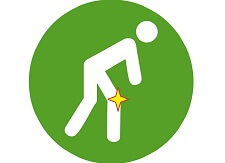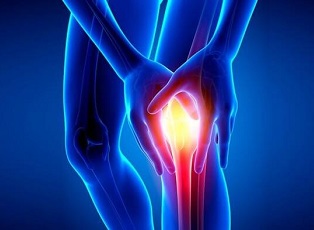- Home
- Common Knee Conditions
- Bursitis
- Housemaids Knee
Housemaids Knee
Written By: Chloe Wilson, BSc(Hons) Physiotherapy
Reviewed by: KPE Medical Review Board
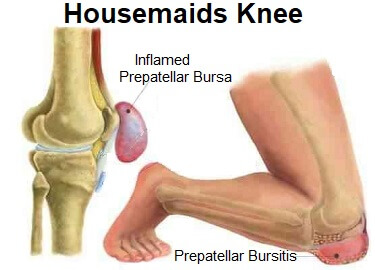
Housemaids knee, also known as prepatellar bursitis, is caused by inflammation of the knee bursa.
The prepatellar bursa, a small fluid-filled sac, sits in front of the kneecap providing cushioning and protection. If there is too much pressure on the bursa, it will produce more fluid to try and protect the knee and start to swell.
Prepatellar bursitis is usually caused by repetitive kneeling or a sudden blow to the front of the knee e.g. a fall.
Housemaids knee is the most common cause of front knee swelling and usually settles down within a few weeks with the correct home treatments, rarely requiring surgical intervention.
Here, we will look at the common causes, symptoms, treatment options and recovery process for Housemaids Knee.
What Is Housemaids Knee?
Housemaids Knee is the most common form of knee bursitis.
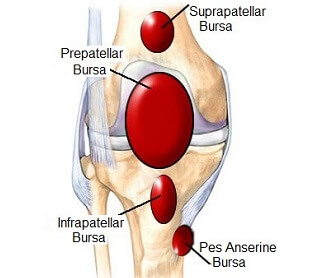
Bursa are small fluid filled sacs found all over the body. Their job is to prevent friction between bone and soft tissues (muscles, tendons, skin and ligaments) and they act like a cushion.
The prepatellar bursa sits in front of the knee cap, just beneath the skin. When the prepatellar bursa gets irritated from friction or pressure, it produces extra fluid to protect the knee joint.
The bursa gradually gets inflamed and swells, becoming painful and putting pressure on the surrounding structures.
This swelling is known as prepatellar bursitis, or more commonly Housemaids Knee, and is the most common cause of swelling on top of the knee.
Causes of Housemaids Knee
The most common causes of Housemaids knee are:
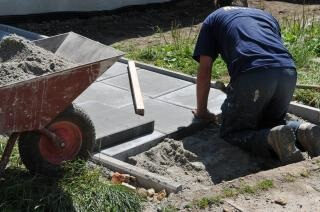
- Repetitive Kneeling: which causes friction and puts pressure on the bursa and kneecap. Nowadays housemaids knee tends to affect tradesmen and gardeners more than housemaids, thanks to the hoover!
- Sudden Force: Prepatellar bursitis can
also be caused by a direct blown or fall onto the front of the knee
- Medical Conditions: You are at increased risk of
developing bursitis of the knee if you have an underlying inflammatory
condition such as rheumatoid arthritis or gout
- Infection: Occasionally it is caused by a bacterial infection e.g. from an open wound
Prepatellar Bursitis Symptoms
The most common symptoms of housemaids knee are:
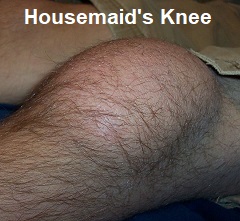
- Swelling: a pocket of swelling at the front of the knee, a bit like a squashy orange or water balloon
- Knee Pain: particularly when moving the knee which can make it difficult to bend the leg, kneel down or walk
- Redness: the knee may appear slightly red and feel warm and tender to touch.
Usually the doctor will be able to diagnose prepatellar bursitis just by looking at your leg - it doesn’t require an x-ray or MRI.
If the likely cause of housemaids knee is an infection, the doctor will remove some of the fluid and have it tested, and you may then be given antibiotics.
#CommissionsEarned from Amazon on qualifying purchases
Prepatellar Bursitis Treatment
Housemaids knee treatment usually consists of:
- PRICE: PRICE is a great treatment tool to help reduce pain
and swelling with housemaids knee and it helps to speed up recovery. It stands for Protect, Rest, Ice, Compress, Elevate. Visit the PRICE section to find out how to
use it safely and effectively
- Medication: Non-steroidal anti-inflammatory medication (NSAIDs) such as ibuprofen/Advil can also help to reduce the swelling and pain associated with prepatellar bursitis. You should always check with your doctor before taking medications
- Stretching: Prepatellar bursitis is often aggravated by tight muscles in the leg, so stretching these muscles out relieves the pressure on the bursa so it stops producing excess fluid. Find the best ways to stretch in the Quads Stretches section
- Avoiding Aggravating Activities: A really important part of prepatellar bursitis treatment is to avoid activities that place pressure on the kneecap and prepatellar bursa e.g. kneeling and squatting to allow time for the swelling to go down
- Gel Knee Pads: If you do have to kneel, wearing gel knee pads can make all the difference with housemaids knee. They take the pressure off the bursa and are excellent for eliminating pain and irritation when you do have to kneel. Visit the gel knee pad section to find out more
- Ice: Ice is a great natural treatment tool to help to reduce the swelling and pain from prepatellar bursitis, however if used incorrectly, it can actually make things worse. Visit the Ice section to find out how to safely and effectively use ice or the ice wrap section for different ways to apply ice
- Aspiration: If the swelling in the prepatellar bursa becomes extreme, then your doctor can drain the fluid out of the bursa with a needle, known as aspiration
- Steroid Injections: Cortisone injections into the bursa can help to reduce swelling and pain associated with housemaids knee. You can find out more in the knee injections section
- Antibiotics: If your housemaids knee is due to an infection, your doctor will prescribe you antibiotics. Usually after around three days of taking them, you should notice the symptoms starting to improve
- Surgery: Very occasionally, if all other treatments have failed and the prepatellar bursitis is causing significant problems, then surgery is required to remove the bursa
Prepatellar Bursitis Recovery
Generally, housemaids knee settles within a few weeks, with the correct prepatellar bursitis treatment. It is important to address any problem areas such as muscle imbalance to reduce the risk of the bursa swelling up again.
If you have already had housemaids knee, it is advisable to avoid kneeling on hard surfaces by using some sort of cushioning such as gel pads to prevent recurrence.
If prepatellar bursitis symptoms last more than 6 months with treatment, and are affecting activities of daily living, then surgery may be advised to remove the bursa.
What Else Could It Be?
Housemaids knee is one of the most common causes of knee pain kneeling and front knee swelling, but there are other options.
The suprapatellar bursa sits just above the knee joint between the quads tendon and the thigh bone. If you swelling and pain is slightly above the kneecap, check out the suprapatellar bursitis section.
The infrapatellar bursa sits slightly below the knee around the patellar tendon. If your pain and swelling is slightly below the knee rather than right over the front of the kneecap, have a look at the infrapatellar bursitis section.
Another common place to get bursitis is at the back of the knee, where there is inflammation of the popliteal bursa. You can find out more in the Bakers Cyst section.
There are a number of other causes of front knee pain other than Housemaids Knee such as:
- Patellofemoral Pain Syndrome
- Knee Tendonitis
- Plica Syndrome
- Meniscus Tears
- Osgood Schlatters
- Swelling On Top Of Knee
If you want some help working out what is causing your pain, visit the Diagnose Your Pain section.
Related Articles
Last Updated: May 14th, 2025
Next Review Due: May 14th, 2027
